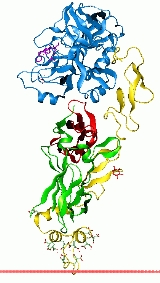
Gla domain
Encyclopedia
Vitamin K-dependent carboxylation/gamma-carboxyglutamic (GLA) domain is a protein domain
that contains post-translational modifications of
many glutamate residues by vitamin K
-dependent carboxylation
to form gamma-carboxyglutamate (Gla). The Gla residues are responsible for the high-affinity binding of calcium ions.
The GLA domain is responsible for the high-affinity binding of calcium ions. It starts at the N-terminal extremity of the mature form of proteins and ends with a conserved aromatic residue; a conserved Gla-x(3)-Gla-x-Cys motif is found in the middle of the domain which seems to be important for substrate recognition by the carboxylase.
The 3D structures of several Gla domains have been solved. Calcium ions induce conformational changes in the Gla domain and are necessary for the Gla domain to fold properly. A common structural feature of functional Gla domains is the clustering of N-terminal hydrophobic residues into a hydrophobic patch that mediates interaction with the cell surface membrane.
; F10
; F2
; F7
; F9
; GAS6
; MGP
; PROC
;
PROS1
; PROZ
; PRRG1; PRRG2; PRRG3; PRRG4;
Protein domain
A protein domain is a part of protein sequence and structure that can evolve, function, and exist independently of the rest of the protein chain. Each domain forms a compact three-dimensional structure and often can be independently stable and folded. Many proteins consist of several structural...
that contains post-translational modifications of
many glutamate residues by vitamin K
Vitamin K
Vitamin K is a group of structurally similar, fat soluble vitamins that are needed for the posttranslational modification of certain proteins required for blood coagulation and in metabolic pathways in bone and other tissue. They are 2-methyl-1,4-naphthoquinone derivatives...
-dependent carboxylation
Carboxylation
Carboxylation in chemistry is a chemical reaction in which a carboxylic acid group is introduced in a substrate. The opposite reaction is decarboxylation.-Carboxylation in organic chemistry:In organic chemistry many different protocols exist for carboxylation...
to form gamma-carboxyglutamate (Gla). The Gla residues are responsible for the high-affinity binding of calcium ions.
The GLA domain is responsible for the high-affinity binding of calcium ions. It starts at the N-terminal extremity of the mature form of proteins and ends with a conserved aromatic residue; a conserved Gla-x(3)-Gla-x-Cys motif is found in the middle of the domain which seems to be important for substrate recognition by the carboxylase.
The 3D structures of several Gla domains have been solved. Calcium ions induce conformational changes in the Gla domain and are necessary for the Gla domain to fold properly. A common structural feature of functional Gla domains is the clustering of N-terminal hydrophobic residues into a hydrophobic patch that mediates interaction with the cell surface membrane.
Human proteins containing this domain
BGLAPOsteocalcin
Osteocalcin, also known as bone gamma-carboxyglutamic acid-containing protein , is a noncollagenous protein found in bone and dentin. In humans, the osteocalcin is encoded by the BGLAP gene.- Function :...
; F10
Factor X
Factor X, also known by the eponym Stuart-Prower factor or as prothrombinase, is an enzyme of the coagulation cascade. It is a serine endopeptidase .-Physiology:...
; F2
Thrombin
Thrombin is a "trypsin-like" serine protease protein that in humans is encoded by the F2 gene. Prothrombin is proteolytically cleaved to form thrombin in the first step of the coagulation cascade, which ultimately results in the stemming of blood loss...
; F7
Factor VII
Factor VII is one of the proteins that causes blood to clot in the coagulation cascade. It is an enzyme of the serine protease class. A recombinant form of human factor VIIa has U.S. Food and Drug Administration approval for uncontrolled bleeding in hemophilia patients...
; F9
Factor IX
Factor IX is one of the serine proteases of the coagulation system; it belongs to peptidase family S1. Deficiency of this protein causes hemophilia B. It was discovered in 1952 after a young boy named Stephen Christmas was found to be lacking this exact factor, leading to...
; GAS6
GAS6
Growth arrest-specific 6, also known as GAS6, is a human gene coding for the Gas6 protein. It is similar to the Protein S with the same domain organization and 43% amino acid identity...
; MGP
Matrix gla protein
Matrix gla protein is a protein found in numerous body tissues that requires vitamin K for its optimum function. It is present in bone , as well as in heart, kidney and lung...
; PROC
Protein C
Protein C, also known as autoprothrombin IIA and blood coagulation factor XIV, is a zymogenic protein, the activated form of which plays an important role in regulating blood clotting, inflammation, cell death and maintaining the permeability of blood vessel walls in humans and other animals...
;
PROS1
Protein S
Protein S is a vitamin K-dependent plasma glycoprotein synthesized in the endothelium. In the circulation, Protein S exists in two forms: a free form and a complex form bound to complement protein C4b. In humans, protein S is encoded by the PROS1 gene...
; PROZ
Protein Z
Protein Z also known as PROZ is a protein which in humans is encoded by the PROZ gene.Protein Z is a member of the coagulation cascade, the group of blood proteins that leads to the formation of blood clots. It is vitamin K-dependent, and its functionality is therefore impaired in warfarin therapy...
; PRRG1; PRRG2; PRRG3; PRRG4;

